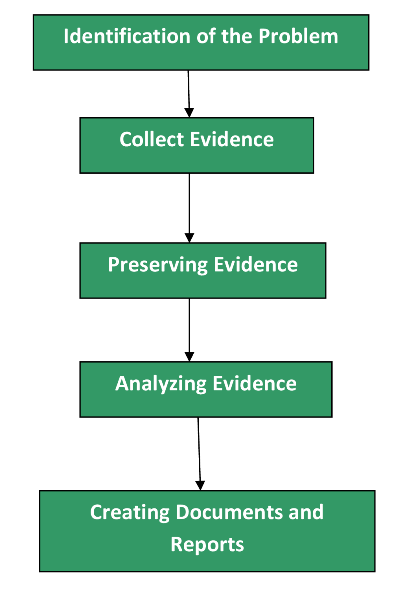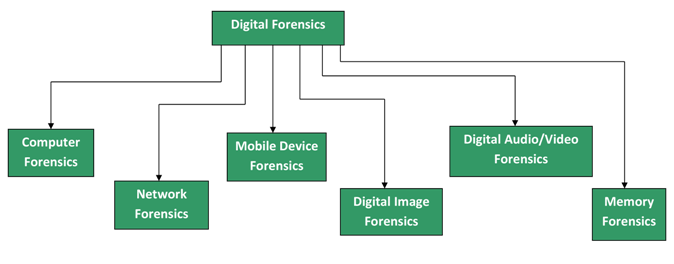Before we go on and talk about What is Digital Forensics?, let us first talk about the meaning of Forensics. Forensics refers to the techniques or the tests that are conducted to get into the depth of a crime.
For example, A robbery has taken place at a house. Police will come in and try to find the fingerprints of the robbers and using those fingerprints, the robbers will be identified by the police. This is forensics.
In the modern-day world, a lot of crimes take place through the use of computers. Computers have evolved a lot in the past few years, and everything from banking to shopping can be done digitally. So naturally, a lot of criminals have come up that make use of different techniques to carry out crimes digitally. This is where Digital Forensics steps in.
Table of Contents
What is the Difference Between Traditional Crimes and Cyber Crimes?
The very basic difference between Traditional Crime and Cyber Crime would be – Cyber Crime involves all the crimes that are carried out, related to the use of technology such as computers, the internet, etc. while traditional crimes involve everything else.
Example: A thief stealing from someone using a gun would be called a traditional crime while a person stealing from a person’s account using bugs in online banking would be called a Cyber Crime.
What is Digital Forensics?
Digital Forensics involves techniques that can be used to identify and detect the evidence from crimes that were carried out digitally. This evidence is collected to be produced in a court of law. In simpler terms, Digital Forensics comes into the scene whenever a digital crime happens, or when a crime is related to computers.
For example, A person steals the data from an organization and manipulates it for his benefit. He then stores the data on an encrypted hard drive. The Digital Forensics department will then use various techniques for the decryption of the hard drive and will produce the evidence in front of a court of law.
Sometimes, people get confused between Digital Forensics and Computer Forensics. Technically, the term Digital Forensics is used in a broader aspect. Computer Forensics deals with crimes related to merely computers, while Digital Forensics involves crimes related to Smartphones, Networks, the Internet, Drives, etc. It can be said that Computer Forensics is a subset of Digital Forensics.
What is the Need for Digital Forensics?
Traditional forensic techniques and crime-fighting units like Police are needed for preventing different traditional crimes. Similarly, Digital Forensic techniques are important for the prevention of Cyber Crimes. There is especially a Cyber Forensics Department for different governments. They can be both private and public.
History of Digital Forensics
Cybercrimes came into origin during the late 1980s and early 1990s. The term ‘Computer Forensics’ was coined for the first time in that era only. The US and UK came up with small units that dealt with issues related to Cyber Crimes.
Then in the early 1990s, officials began to realize that there was a need for setting some protocols and standards involving computer forensics. Various conferences were held at Police Staff College at Bramshill from 1994 to 1995. Officials from the US and UK attended the conferences to come up with powerful protocols and standards. The development of various guidelines took place during this period. With time, these guidelines kept evolving and are now widely accepted as forensics standards. The term computer forensics or cyber forensics also evolved into Digital Forensics.
Examples of Digital Forensics
- Suppose a person wants to buy the software but does not have any money for it. Instead of saving up to buy the software later, he illegally downloads the pirated version of that software. He keeps on using it and earns money for himself using that software. Someone comes to know about this and informs the developers of the company. The company investigates the matter with the help of the Forensics Department and sues the person. This was a really basic example of issues related to Digital Forensics.
- Let us take another common example of Digital Forensics. A person is browsing through the internet and comes across a website that asks him to invest a few dollars. In return, the website will double the money in 10 days. The person happily puts in a few dollars, but the website does not perform as promised and does not return his money. He then seeks the help of police, who consult the Forensics Department. The Forensics department then investigates the matter and helps the man get his money back.
Advantages and Disadvantages of Digital Forensics
Just like every other thing in the world, Digital Forensics has its advantages and disadvantages. Let us take a look at them.
Advantages
- Digital Forensics helps in producing pieces of evidence in the court of law whenever a cybercrime takes place.
- It helps the companies in protecting their software and helps them in being secure.
- Digital Forensics helps in maintaining the integrity of an individual/ organization.
- It helps in tracking criminals who perform cyber-crimes.
- Digital Forensics has helped in making the internet a safer place for people.
Disadvantages
- Digital Forensics is endless and new crimes and criminals keep evolving every day.
- Criminals are always a step ahead of crime fighters.
- Whenever a piece of evidence is produced in the court of law, it has to be proved that it has not been tampered with.
- Sometimes, fake shreds of evidence are generated and produced in front of the court.
- The forensic investigator must be having a good knowledge of his field to investigate cybercrimes.
Steps Involved in Digital Forensics
Let us now talk about the Digital Forensics process. This topic includes the steps that are taken during a Forensics Investigation.

Identification of the problem
The first step in the process of investigation is identification. During this step, the Forensics investigators try to figure out the intensity of the crime and how it was carried out. During this phase, certain guidelines are followed by the Forensics Investigator so that the evidence/ data does not get damaged.
Collecting Evidence
The second and the most obvious step in a Forensics Investigation is to collect evidence. This evidence includes everything from emails, to share files, to hard disk drives, etc. The criminal’s and the victim’s digital signatures are traced to collect all the necessary data that can be used as evidence.
Preserving Evidence
Once the evidence has been collected, it is very important to preserve it. The original evidence is not tampered with, and its replica images are created by the Forensics Investigators. Further work is usually done on these images rather than the original evidence to keep it preserved.
Analyzing Evidence
Once the evidence has been replicated and the original evidence has been preserved, analysis is done. The replicated files are analyzed by Forensics Experts to get into the depth of the crime.
Creating Documents and Reports
The final step in the process is reporting. All the analyzed data is then made into a report that tells about the crime, how it took place, what steps did the criminals use and how was it implemented.
Digital Forensics Types
Digital Forensics is a vast field on its own and has numerous types that are discussed below.

- Computer Forensics: This area involves crimes that are related to computing devices like PCs, laptops, and storage devices like USB Sticks, etc.
- Network Forensics: This area involves the crimes that take place on a certain network. The network may belong to an organization or the whole internet.
- Mobile Forensics: As the name suggests, this area involves crimes related to mobile devices like smartphones, tablets, consoles, and other electronic devices.
- Digital Image Forensics: This area involves the processing and analysis of images that have been retrieved digitally. This area tests the authenticity of such images.
- Digital Video/Audio Forensics: This area retrieves and analyzes the sound and videos collected during the investigation.
- Memory Forensics: This area involves the recovery of data and evidence from the Random Access Memory of the computer.
Digital Forensics Tools
There is numerous digital forensics software that is used in Forensics Investigations. You can try some of these tools yourself to better understand the working of Digital Forensics. Let us take a look at some of these tools.
Open Computer Forensics Architecture
This software is open source and is built on Linux. The database is used to store data in PostgreSQL. This tool helps with numerous things and can be used by both professionals and non-professionals. You can recover deleted files using this software and can access remote devices.
Digital Forensics Framework
This is one of the most popular tools in Digital Forensics. It is an amazing tool because it is open source, which means it is free for everyone to use. This tool can be used for the recovery of deleted files and for accessing remotes.
X-Ways Forensics
If you are seeking a tool that is rich in features, you do not need to look beyond this one. This tool is run on Windows Operating Systems. Some of its awesome features are Cloning and Disk Imaging, mounting, Checking Data Authenticity, Memory Analysis, Extracting Metadata, Recovery of Deleted files, etc.
Registry Recon
When you talk about premium Digital Forensics tools, Registry Recon is the first one that comes to mind. Although it is not free and costs $399, its price is all worth it. Various professionals use it for research purposes.
LlibForensics
This tool was specially designed in Python for the design and development of Digital Forensics applications. If you are a developer and are interested in Forensics, try this tool out.
Digital Forensics Internship
If you are a student but you want to work in a professional environment while still learning, you can grab some good internships. A lot of companies give out vacancies for interns in various fields. Digital Forensics is a comparatively newer field, so a lot of emerging companies want talented interns to work for them.
As a forensics intern, you will have to work with various tools to perform certain tasks. For example, you might have to work in a tool to recover deleted files. In India, these types of internships are a bit less in number as compared to the US and UK, but there are still several opportunities. If you are a student, try to get in touch with a Digital Forensics faculty so that he could recommend you to a company where you can be an intern. You can also browse the internet and look for internships on trusted websites like Internshala.com
Digital Forensics Jobs
In terms of career, Cybersecurity has been booming. There are a lot of jobs coming up in the field of Digital Forensics. If you are a certified Digital Forensics expert or you have done your UG/ PG in Digital Forensics, then you can apply for various jobs in different companies. Most of these companies are based in Metros like Bangalore, Delhi, Hyderabad, etc.
Most of these jobs require you to be an expert on certain tools. So it will be better if you enroll in certified courses of multiple digital forensics tools.
